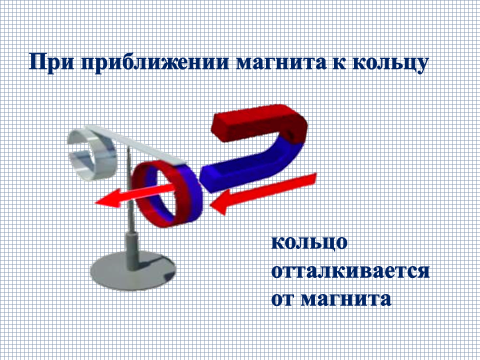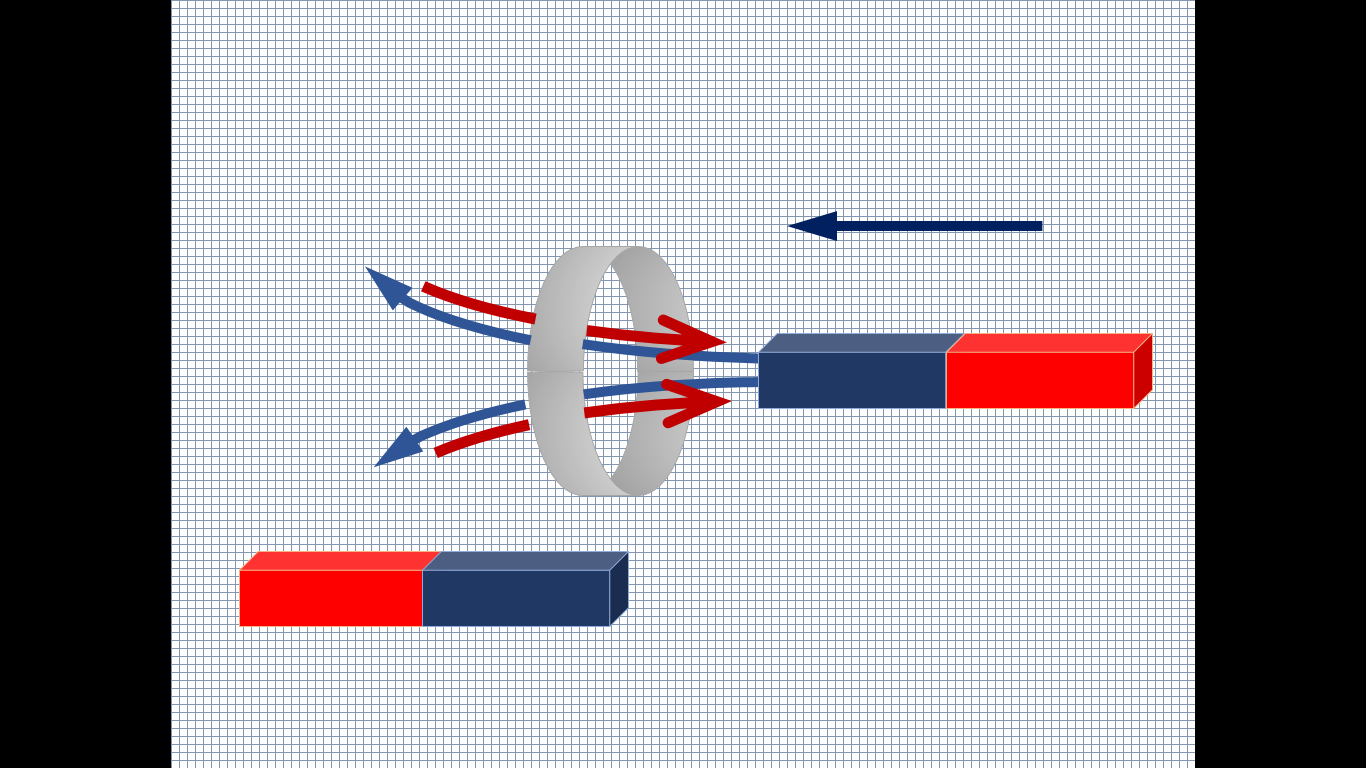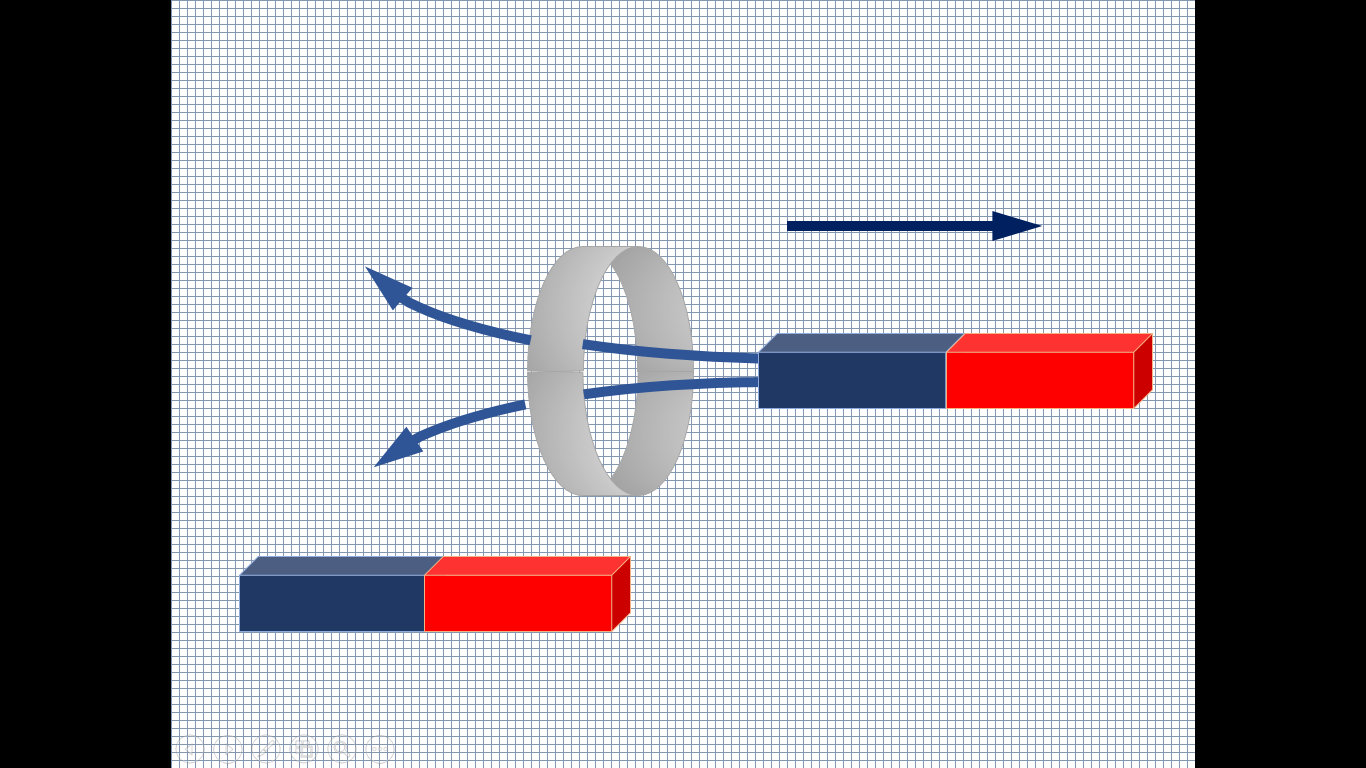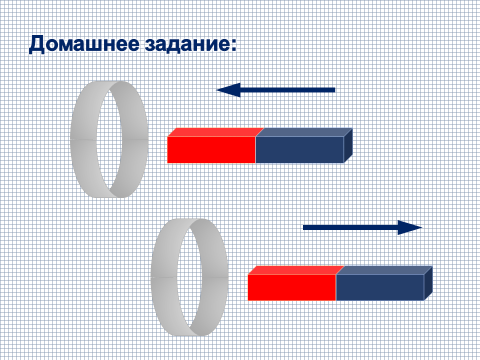
Lesson objectives:
Lesson type: learning new material
Teaching methods: Method of problem presentation, partially search.
Forms of organization of cognitive activity:
Equipment: electronic board, presentation, multimedia course Physics: complete course. 7-11 grades (edited by V. Akopyan), strip magnet, connecting wires, galvanometer, milliammeter, coils, current source, key, wire coils, arc-shaped magnet, device for demonstration of Lenz's rule.
Lesson Plan
| Lesson steps | Time, min | Techniques and Methods |
| Creation of a problem situation, historical information | 8 min | Creation of a problem situation by the teacher. Demonstrations that lead to the purpose of the lesson. |
| Studying new material during experimental work in groups (EMP phenomenon, Lenz’s rule) | 2 minutes | Experiment. Observation. Highlighting the main thing. Formulation of conclusions. |
| Studying new material (rules for determining the direction of induction current, the law of electromagnetic induction). | 20 minutes | Conversation. Answers on questions. |
| Summarizing. Homework. | 5 minutes | Highlighting the main thing. Assessment (peer assessment) "Chain". |
During the classes
1. Creation of a problematic situation (long-term perspective)
Hello guys! The slide (Slide 1) of the presentation shows power line supports in different countries: in Finland, for example, in the form of deer. But the supports do not change the content: all power lines are designed to transmit electric current on long distances, and all power lines are high-voltage.
Why are all power lines high voltage?
(Students’ answers, as a rule, are “High voltage current is flowing”).
Why increase the voltage? (Slide 2). Look at the power transmission diagram: the transformer increases the already high voltage, and in everyday life, in lighting network You only need 220V! So why increase the voltage? ( Students' answers)
While we were having a conversation with you, an electric current flowed through a coil of wire.
Demo 1: A coil of wire is fixed in the tripod leg, and an electric current is passed through it.
(Students’ answers, as a rule, are “The conductor through which current flows heats up. This is the thermal effect of current.”).
Well done, that's right! The current flowing through the power line heats the line (wire), and energy is lost: part of the electrical energy is converted into thermal energy. Thermal energy losses must be minimized. (Slide 3) Let's remember the Joule-Lenz law: reduce heat losses You can, for example, reduce the current. A device that reduces the current and at the same time increases the voltage by the same amount (and vice versa), with virtually no loss of power, was invented in 1878 by the Russian scientist P.N. Yablochkov and was called a transformer.
Let's summarize briefly: in order to reduce heat losses when transmitting electricity over long distances, it is necessary to reduce the current strength, and this role will be performed by a step-up transformer, but at the same time it will increase the voltage by the same amount. This is why all power lines are high voltage.
2. Creation of a problematic situation (short term)
But on what principle is the operation of a transformer based?
(Students find it difficult to answer)
His work is based on the phenomenon of electromagnetic induction, which was discovered by Michael Faraday in 1831 and is the greatest discovery of the 19th century. (Slide 4)
The principle of operation of induction furnaces (OMD, steelmaking) and logs, induction hobs (Technologist), metal detectors, transformers (Welder) and alternating current generators (Maintenance of electrical and electromechanical equipment) is based on this phenomenon. Your future profession (specialty) is inextricably linked with this phenomenon: without the electric current generated by generators on the ES, the operation of machine tools (Machine Operator), electromagnets (Crane Operator), electric ovens and slabs (Technologist), etc.
Demonstration 2. The skein is fixed in the tripod leg, an electric current is passed through it, and a magnet is brought in.
What effect of electric current can be seen?
(Students’ answers, as a rule, are “Magnetic. If current flows through a conductor, a magnetic field appears around the conductor.”). Well done!
Right. If an electric current generates a magnetic field, then couldn’t the magnetic field, in turn, generate an electric current?
In 1821, Michael Faraday was puzzled by this question. “Convert magnetism into electricity” was written in his diary. Ten years later, on August 29, 1831, this problem was solved.
Write down the topic of the lesson. PHENOMENON OF ELECTROMAGNETIC INDUCTION. LAZY RULE. LAW OF ELECTROMAGNETIC INDUCTION.
Let's experimentally establish under what conditions a magnetic field can generate an electric current in a conductor (circuit).
(Students perform experimental tasks in groups).
Let's summarize the work of our groups:
1 group (Students' answers). (Slide 5) (answers from students in group 1 are supplemented by responses from students from other groups)
Conclusion: In a conductive closed circuit arises electricity , if the contour is in alternating magnetic field or moves in a time-constant field so that the number of magnetic induction lines penetrating the circuit changes.
From the history of the issue: Almost simultaneously with Faraday, the Swiss physicist Colladon tried to obtain an electric current in a coil using a magnet. When working, he used a galvanometer, the light magnetic needle of which was placed inside the coil of the device. To prevent the magnet from directly influencing the needle, the ends of the coil into which the magnet was inserted were brought into the next room and there connected to a galvanometer. Having inserted the magnet into the coil, Colladon went into the next room and was disappointed to see that the galvanometer did not show any current. If only he had been near the galvanometer all the time and asked someone to work on the magnet, a remarkable discovery would have been made. But this did not happen. A magnet at rest relative to the coil does not generate current in it.
Let us introduce the concept of magnetic flux. (Slide 6)
Magnetic flux - physical quantity, equal to the product of the magnitude of the magnetic induction vector B and the area S cosine of the angle? between vectors and
1 Wb = 1 T*1m 2
A magnetic flux of 1 Weber is created by a magnetic field with an induction of 1 T through a surface with an area of 1 m 2 located perpendicular to the magnetic induction vector.
The current that arises in a closed circuit when the magnetic flux passing through the circuit changes is called induced current.
2nd group (Students' answers).
Conclusion: The magnitude of the induction current depends (Slide 7)
General conclusion of the work of groups 1 and 2:
The phenomenon of the appearance of an induced current in a closed circuit when the magnetic flux penetrating the circuit changes is called the phenomenon of electromagnetic induction.
3 group (Students' answers). (Slide 8). Lenz's rule.
Investigating the phenomenon of electromagnetic induction, E. H. Lenz established in 1833 general rule to determine the direction of the induction current:
The induced current arising in a closed circuit with its magnetic field counteracts the change in the magnetic flux that caused it.
Direction of induction current.
Rule right hand
If the right hand is positioned so that vector B enters the palm, and the thumb bent by 90° is directed along the movement of the conductor, then the four fingers of the hand will indicate the direction of the induction current to the conductor.
When explaining the material, you can use the multimedia course Physics: complete course. Grades 7-11 (edited by V. Akopyan) (lesson “The phenomenon of electromagnetic induction”)
Law of Electromagnetic Induction
It is known that an electric current appears in a circuit when external forces act on the free charges of a conductor. The work done by these external forces when moving a unit positive charge along a closed loop is called electromotive force. Consequently, when the magnetic flux changes, through the surface limited by the contour, extraneous forces appear in the latter, the action of which is characterized by the emf, called induced emf.
~ and =, then = - for 1 turn = * N- for N turns
According to Lenz's rule:
= - *N - for N turns
The induced emf in a closed loop is equal in magnitude to the rate of change of the magnetic flux through the surface bounded by the loop.
Guys, today we got acquainted with the phenomenon of electromagnetic induction (EMI). The operation of many devices is based on this phenomenon; a special role should be given to alternating current generators, in which mechanical energy is converted into electrical energy. It is almost impossible to imagine the life of a modern person without electric current, just like yours. future job: induction hobs – Technolog, induction furnaces- OMD, transformer – Welder, etc.
Let's summarize the lesson and answer the questions:
Questions:
1. What is the phenomenon of electromagnetic induction?
2. What is magnetic flux called?
3. How is the work of a machine operator (crane operator, locomotive driver, etc.) related to the EMI phenomenon?
4. Why is the law of electromagnetic induction formulated for emf, and not for current? Formulate the law of EMR.
5. Why is there a minus sign in the law of electromagnetic induction?
6. How to determine the direction of the induction current?
Today we worked fruitfully, conducted experiments, guys, evaluate the work of each group: the work of your group and the work of students in other groups.
(Discussion, dialogue between students)
3. Homework:
8-11, abstract, p. 27 (give examples of the occurrence of induction current using two coils on a common core), prepare messages (Metal detectors, magnetic levitation train, induction furnaces, induction hobs).
Chain:
As usual, we leave the class along the “chain” (it is necessary to name the physical quantity and the units of measurement of the physical quantity).
Annex 1
Appendix 2
Appendix 3
Physics lesson notes in 8th grade.
Subject. Lenz's rule.
Goals:
educational:
Formulate Lenz's rule to determine the direction of the induction current;
Develop skills in applying Lenz’s rule;
developing:
Develop the skills to observe, compare, compare and summarize the results of experiments;
Develop the ability to find a solution to a problem;
educational:
- cultivate cognitive need and interest in the subject;
Expand students' horizons.
Equipment: device for demonstrating Lenz's rule, strip and arc magnets, galvanometer, coil, screen, laptop, projector, handouts (task cards), presentation.
During the classes.
I. Organizational moment.
The English philosopher Herbert Spencer once said: “The treasures are not the knowledge that is deposited in the brain like fat, the treasures are those that turn into mental muscles!”
These words will be the epigraph to the lesson in which we will have to work our “brain muscles.”
II. Checking homework.
Express test.
The phenomenon of electromagnetic induction.
1. When pushing the magnet with the north pole into the coil...
2. When moving the magnet with the north pole out of the coil...
B. in some cases an induced current occurs in the coil
3. When moving the magnet with its south pole out of the coil...
A. no induced current occurs in the coil
B. an induced current occurs in the coil
B. in some cases an induced current occurs in the coil
4. When pushing the magnet with the south pole into the coil...
A. an induced current occurs in the coil
B. no induced current occurs in the coil
B. in some cases an induced current occurs in the coil
5. If the magnet is stationary relative to the coil...
A. no induced current occurs in the coil
B. an induced current occurs in the coil
B. in some cases an induced current occurs in the coil
6. If you move the coil relative to a fixed magnet...
A. an induced current occurs in the coil
B. no induced current occurs in the coil
B. an induced current sometimes occurs in the coil
7. The strength of the induction current is greater...
A. slowly push the magnet into the coil
B. quickly move the magnet out of the coil
B. slowly pull the magnet out of the coil
A. direction of movement of the magnet relative to the coil (magnet is added or removed)
B. on which pole the magnet is inserted or removed
B. the direction of movement of the magnet relative to the coil (a magnet is added or removed) and from which pole the magnet is inserted or removed
9. The phenomenon of electromagnetic induction...
A. this is the phenomenon of the occurrence of electric current in a closed circuit when the external magnetic field inside the coil
B. this is the phenomenon of the occurrence of electric current in a closed circuit
B. this is the phenomenon of the appearance of a magnetic field in a closed circuit
10. The phenomenon of electromagnetic induction was discovered...
A. Oersted
W. Faraday
Work in pairs: mutual testing.
(each student gives answers in two copies: one is for mutual checking, the second is submitted for checking by the teacher).
10 correct answers - “5”, 8-9 - “4”, 7 - “3”, 6 - “3-”, 5 or less - “2”.
Psychological relaxation - health preservation.
“A” - they clapped their hands.
“Fours” - they clapped their hands.
“Troikas” sighed.
“Twos” - took a deep breath.
III . Motivation for learning activities.
Hermann Ludwig Ferdinand Helmholtz, a German physicist, said about the discovery of Michael Faraday: “As long as people enjoy the benefits of electricity, they will always remember the name of Faraday with gratitude.”
Faraday indicated the reason for the occurrence of induced current - this is a changing magnetic field. In addition, for each specific case (for each experiment), the direction of the induction current was indicated.
What do you think, if there is one reason for the occurrence of current, then there is general approach to determining the direction of the induction current, and not in each case?
Possible answer. Exists.
Indeed, there is a rule that determines the direction of the induction current.
IV . Goal setting.
What goal do we set for ourselves in the lesson?
Possible answer. Study the rule that will allow you to determine the direction of the induction current.
V. Message of the topic of the lesson.
(written down in notebook)
VI . Learning new material.
After Faraday’s discovery of the phenomenon of electromagnetic induction, a number of scientists proposed rather complex “rules” that make it possible in particular cases to determine the direction of the induction current.
Having carefully studied all the works in this area, the Russian physicist, one of the founders of electrical engineering, Emilius Christianovich Lenz, carried out a number of original experiments in 1832, and in November 1833 he gave a report at the Academy of Sciences “On determining the direction of galvanic currents excited by electrodynamic induction "
You and I can also establish this rule with the help of simple experience.
The device consists of two aluminum rings connected by an aluminum crossbar. One of these rings has a cut (not closed), the second ring is solid. The crossbar is mounted on the tip of a needle, which is fixed to a stand.
Experiment 1. Insert a magnet into a ring with a cut.
What are you observing?
Answer. No changes are observed.
Experiment 2. Place a magnet with its north pole into a solid ring.
What are you observing?
Answer. The ring moves away from the magnet.
Experiment 3. Pull a magnet out of a solid ring.
What are you observing?
Answer. The ring follows the magnet.
Experiments 4-5. Repeat the experiment by sliding the magnet in and out of the solid ring with the south pole.
What are you observing?
When a magnet is brought into the solid ring, its south pole moves away from the magnet. When the magnet is removed from the ring, the ring follows it.
Thus, when any pole of a magnet is inserted into a solid ring, the ring moves away from it, and when a magnet is pulled out of the ring by any pole, the ring follows the magnet.
Let us explain the observed phenomena.
Heuristic conversation.
Demonstration. What happens when you push a magnet into a coil?
Answer. An induced current occurs in the coil.
What happens when you push a magnet into a ring?
Answer. An induced current occurs in the ring.
What does the occurrence of induction current lead to?
Answer. A magnetic field appears around the current-carrying ring.
So, the ring acquires the properties of a magnet, and we observed the interaction of a magnet with a magnet ring.
How do the poles of magnets interact?
Answer. Opposite poles attract, like poles repel.
Since the ring is repelled from the magnet, it follows that the ring and the magnet face each other with the same poles.
Demonstration. What can we say about the direction of the induction current when moving the magnet in and out of the coil?
Answer. The current that arises when the magnet is pushed in is in one direction, and when pulled out it is in the opposite direction.
As the magnet moves out of the ring, the ring follows the magnet. The direction of the current has been reversed, and the ring now faces the opposite pole to the magnet.


Physical education minute.
During the lesson we will work the muscles of the eyes, the muscles of the fingers, and the muscles of the hands.
Let's continue. Let us depict the mechanism of what is happening.


What are they? magnetic lines magnetic field of a strip magnet?
Answer. The magnetic lines of a strip magnet are closed lines that leave the north pole and enter the south pole.


Let's apply the right hand rule to the ring: if you point the thumb of your right hand in the direction of the magnetic lines, then the four bent fingers will indicate the direction of the current in the ring.

Now let's look at what happens if you move the magnet out of the ring.





In a split ring, no induction current occurs; the ring does not interact with the magnet.
By moving away from the approaching magnet, the ring counteracts the increase in the external magnetic field passing through it. Following the retreating magnet, the ring counteracts the decrease in the external magnetic field passing through it.
Thus, we came to the same conclusion as in 1833 by Emilius Christianovich Lenz:
The induced current arising in a closed circuit with its magnetic field counteracts the change in the external magnetic field that caused this current.

Lenz's rule is a consequence of the law of conservation of energy.
V . Consolidation of the studied material.
Let us repeat the steps of applying Lenz's rule to determine the direction of the induction current:
1. Find out whether the magnet is moving closer or further away from the closed circuit. That is, we find out how the magnetic field changes through a closed loop.
2. Show the magnetic lines of this (external) magnetic field.
3. We show the magnetic lines of the magnetic field of the induction current:
If the external magnetic field increases, then the magnetic lines of the magnetic field of the induction current are directed opposite to the magnetic lines of the external magnetic field;
If the external magnetic field decreases, then we direct the magnetic field lines of the induced current in the same way as the magnetic lines of the external magnetic field.
4. Applying the right-hand rule, we determine the direction of the induction current.
VI . Homework.
§22 (teach).
Exercise. How is the induced current directed in the ring:
a) push the magnet into the ring with the south pole;
b) move the magnet out of the ring with its south pole.

VII . Reflection.
How did you work your brain muscles?
"Great!" - clapped;
Did you feel the “beauty” of Lenz’s rule?
"Everything worked out!" - clapped;
“Not very…” - they took a deep breath.